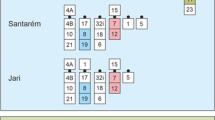Abstract
DNA sequencing reveals that the genomes of the human, gorilla and chimpanzee share more than 98% homology. Comparative chromosome painting and gene mapping have demonstrated that only a few rearrangements of a putative ancestral mammalian genome occurred during great ape and human evolution. However, interspecies representational difference analysis (RDA) of the gorilla between human and gorilla revealed gorilla-specific DNA sequences. Cloning and sequencing of gorilla-specific DNA sequences indicate that there are repetitive elements. Gorilla-specific DNA sequences were mapped by fluorescence in-situ hybridization (FISH) to the subcentromeric/centromeric regions of three pairs of gorilla submetacentric chromosomes. These sequences could represent either ancient sequences that got lost in other species, such as human and orang-utan, or, more likely, recent sequences which evolved or originated specifically in the gorilla genome.
Similar content being viewed by others
References
Chu WM, Ballard R, Carpick BW et al. (1998) Potential Alu function: regulation of the activity of double-stranded RNA-activated kinase PKR. Mol Cell Biol 18: 58-68.
du Manoir S, Spcicher MR, Joos S et al. (1993) Detection of complete and partial chromosome gains and losses by comparative genomic in situ hybridization. Hum Genet 90: 590-610.
Gerber HP, Seipel K, Georgiev O et al. (1994) Transcriptional activation modulated by homopolymeric glutamine and proline stretches. Science 263: 808-811.
Goodman M, Tagle DA, Fitch DH et al. (1990) Primate evolution at the DNA level and a classification of hominoids. J Mol Evol 30: 260-266.
Hacia JG, Makalowski W, Edgemon K et al. (1998) Evolutionary sequence comparisons using high-density oligonucleotide arrays. Nature Genet 18: 155-158.
Hancock JM (1996) Simple sequences and the expanding genome. BioEssays 18: 421-425.
Kallioniemi A, Kallioniemi OP, Sudar D et al. (1992) Comparative genomic hybridization for molecular cytogenetic analysis of solid tumors. Science 258: 818-821.
Li et al. (1999) Physiological stresses increase mouse short interspersed element (SINE) RNA expression in vivo. Gene 239: 367-372.
Lisitsyn NA (1995) Representational difference analysis: finding the differences between genomes. Trends Genet 11: 303-307.
Lisitsyn N, Lisitsyn N, Wigler M (1993) Cloning the differences between two complex genomes. Science 259: 946-951.
Miller DA (1977) Evolution of primate chromosomes. Science 198: 1116-1124.
Miller DA, Firschein IL, Dev VG et al. (1974) The gorilla karyotype: chromosome lengths and polymorphisms. Cytogenet Cell Genet 13: 536-550.
Pennisi E (1998) How the genome readies itself for evolution. Science 281: 1131-1134.
Royle NJ, Baird M, Jeffreys J (1994) A subterminal satellite located adjacent to telomeres in chimpanzees is absent from the human genome. Nature Genet 6: 52-56.
Schmid M, Haaf T (1984) Distamycin A/DAPI bands and the effects of 5-azacytidine on the chromosomes of the chimpanzee, Pan troglodytes. Cytogenet Cell Genet 30: 192-199.
Schmid M, Haaf T, Ott G et al. (1986) Heterochromatin in the chromosomes of the gorilla: characterization with distamycin A/DAPI, D287/170, chromomycin A3, quinacrine, and 5-azacytidine. Cytogenet Cell Genet 41: 71-82.
Schmid CW (1998) Does SINE evolution preclude Alu function? Nucleic Acids Res 26: 4541-4550.
Seuánez HN, Carothers AD, Martin DE, Short, RV (1977) Morphological abnormalities in the spermatozoa of man and the great apes. Nature 270: 345-347.
Toder R, Zeitler S, Goodfellow PN et al. (1993) Comparative mapping of SRY in the great apes. Chromosome Res 1: 117-120.
Toder R, Xia Y, Bausch E (1998) Interspecies comparative genome hybridization and interspecies representational difference analysis reveal gross DNA differences between humans and great apes. Chromosome Res 6: 487-494.
Author information
Authors and Affiliations
Rights and permissions
About this article
Cite this article
Toder, R., Grützner, F., Haaf, T. et al. Species-specific evolution of repeated DNA sequences in great apes. Chromosome Res 9, 431–435 (2001). https://doi.org/10.1023/A:1011605824530
Issue Date:
DOI: https://doi.org/10.1023/A:1011605824530




